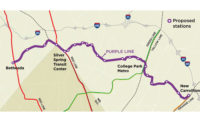Maryland Revives Baltimore's Red Line Transit Project

Maryland Gov, Wes Moore plans to revive the Red Line, a multi-billion-dollar east-west transit project across Baltimore that was cancelled by his predecessor nearly a decade ago.
Image courtesy of Maryland Transit Administration and Maryland Dept. of Transportation
Maryland Gov. Wes Moore (D) has announced plans to revive the Red Line, a multi-billion-dollar east-west transit project across Baltimore cancelled by his predecessor nearly a decade ago.
Originally planned as a 14-mile, 19-station light rail line stretching from the Centers for Medicare & Medicaid Services headquarters in Baltimore County to the Johns Hopkins Bayview Medical Center in Baltimore City, the original $2.9-billion Red Line had qualified for a $900-million Federal Transit Administration New Starts grant in 2014.
A year later, newly inaugurated Gov. Larry Hogan (R) cancelled the project, calling it a “wasteful boondoggle” amid concerns such as the cost of tunneling through densely developed downtown areas, an effort projected at the time to cost $1 billion.
Instead, Hogan opted to back the Purple Line across Washington, D.C.’s northern suburbs that was being developed as a public-private partnership. Since its delayed 2017 groundbreaking, the light rail project has experienced no shortage of controversy, costing the state millions to settle with the original Fluor-led design-build team in 2020, which then departed the project after months of delays and overruns. Restarted last year with Dragados and OHL leading the construction effort, the Purple Line is now set for completion in mid-2027—more than four years behind its original schedule and nearly double its original $2-billion construction cost.
Moore said reviving the Red Line provides an opportunity “to get things right” in terms of linking underserved areas of Baltimore with job centers. He admitted that making the project a reality will require more than simply dusting off the original plans and studies, however. In addition to updating environmental documents, the Maryland Transit Administration (MTA) will need to evaluate alignment adjustments in light of recent corridor development patterns, links to other transit systems and the feasibility of extending the Red Line eastward to a revitalized waterfront industrial area that now boasts an Amazon fulfillment center and other logistics businesses.
MTA will also reassess whether the Red Line should use light-rail or bus rapid transit—options considered in the original environmental studies—and a potential reduction or elimination of tunneling in favor of on-street alignments.
Nevertheless, Moore laid out an ambitious schedule for refining Red Line alternatives and incorporating public feedback in time for MTA to request entry into the federal Capital Investment Grants program by early 2024. While Maryland hopes to take advantage of additional federal transit support under the Infrastructure Investment and Jobs Act, the state will likely need additional sources of funding for design and construction, which Moore said could begin as early as 2026.
“This is going to happen,” Moore asserted in his announcement.
During his successful campaign to be governor in 2022, Moore was highly critical of another of Hogan’s transportation initiatives—the privately financed express lanes along the I-495 Beltway and I-270 near Washington. Transurban, leader of the $6-billion plan’s private development consortium, withdrew in March, citing in part the new administration’s lack of enthusiasm for the express lanes. But Moore said at the time that the project would move forward “in a manner that ensures social equity, environmental protection and engagement with local partners while always acting in the best interest of taxpayers.”



